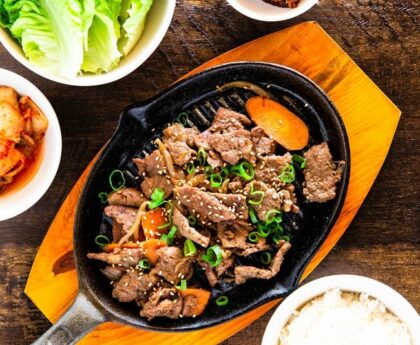
Introduction to Slow Cooker Beef Stew
Slow cooker beef stew has long been a beloved dish in many households, renowned for its comforting and hearty qualities. This culinary classic stands out not only for its rich flavors but also for its versatility, making it a perfect meal option regardless of the season. Whether enjoyed on a chilly winter evening or as a wholesome dinner during the warmer months, beef stew remains a staple for those seeking a satisfying and nourishing meal.
One of the primary advantages of preparing beef stew in a slow cooker is the convenience it offers. The slow cooker, often referred to as a “set it and forget it” appliance, allows for a hands-off approach to cooking. This makes it particularly appealing for busy individuals and families who may not have the time to engage in more labor-intensive cooking methods. Simply combine the ingredients, set the timer, and let the slow cooker work its magic throughout the day.
The nutritional benefits of slow cooker beef stew cannot be overstated. Lean beef, a key ingredient, serves as an excellent source of high-quality protein, essential for muscle repair and growth. Additionally, beef provides important vitamins and minerals such as iron, zinc, and vitamin B12. The inclusion of a variety of vegetables, such as carrots, potatoes, and celery, further enhances the stew’s nutritional profile. These vegetables contribute essential vitamins, minerals, and dietary fiber, promoting overall health and well-being.
In summary, slow cooker beef stew offers a blend of convenience, nutrition, and comfort. Its ability to cater to busy lifestyles while providing a wholesome, delicious meal makes it a timeless favorite. Whether you’re seeking a meal that requires minimal preparation or looking to enjoy a nutritious dish with minimal effort, slow cooker beef stew stands out as an ideal choice.
Ingredients and Preparation
Crafting a delicious slow cooker beef stew begins with selecting the finest ingredients. The primary component is beef, and a chuck roast is ideal due to its marbling, which renders well during slow cooking, imparting rich flavor and tenderness to the stew. Aim to use about two pounds of chuck roast, cut into one-inch cubes.
Vegetables are integral to the stew, contributing both nutrition and depth of flavor. You will need three medium carrots, peeled and sliced into half-inch rounds, and three medium potatoes, peeled and chopped into one-inch cubes. Additionally, two stalks of celery, sliced thinly, will add a subtle crunch and aromatic quality. Including one large onion, diced, and three cloves of garlic, minced, will enhance the overall taste profile.
For seasonings, balance is key. A teaspoon of dried thyme, two bay leaves, and a teaspoon of salt will form the base. Freshly ground black pepper to taste and two cups of beef broth will ensure your stew is savory and comforting. To add a slight richness, incorporate a tablespoon of Worcestershire sauce. A quarter cup of flour, used to coat the beef cubes, will help thicken the stew as it cooks.
Proper preparation is crucial for maximizing flavor. Begin by browning the beef cubes in a hot skillet with a bit of oil. This step is essential as it caramelizes the meat’s surface, creating a depth of flavor that will permeate the entire dish. Once browned, transfer the beef to the slow cooker. In the same skillet, sauté the onions and garlic until fragrant, then add them to the slow cooker alongside the beef. Layer the chopped carrots, potatoes, and celery on top.
Finally, sprinkle the thyme, salt, and pepper over the ingredients, add the bay leaves, and pour the beef broth and Worcestershire sauce over everything. Stir gently to combine. Cover the slow cooker and cook on low for 7 to 8 hours or on high for 4 to 5 hours, until the beef is tender and the vegetables are cooked through.
Step-by-Step Cooking Instructions
Creating a slow cooker beef stew with vegetables is a straightforward process that yields delicious results. Begin by preparing all your ingredients. Cut the beef into bite-sized pieces, and chop your vegetables, ensuring they are of uniform size to promote even cooking.
Layering the ingredients in your slow cooker is crucial for optimal results. Start by placing the beef at the bottom of the slow cooker. This positioning allows the meat to cook thoroughly and absorb the juices from the vegetables and broth. On top of the beef, add your root vegetables such as potatoes, carrots, and parsnips. These heartier vegetables require a longer cooking time and will benefit from being closer to the heat source.
Next, add your softer vegetables like onions, celery, and peas. These vegetables require less cooking time and will not become overly mushy if placed higher up in the slow cooker. Pour your broth or stock over the entire mixture, ensuring that the liquid just covers the ingredients. This liquid is essential for creating a rich and flavorful stew.
Set your slow cooker to the desired setting. Cooking on low for 8-9 hours is recommended for the most tender beef, while cooking on high for 4-5 hours can achieve quicker results. Regardless of the setting, avoid lifting the lid frequently during the cooking process, as this releases heat and can extend cooking time.
To ensure the beef becomes tender and the vegetables remain intact, gently stir the stew halfway through the cooking process. Check the stew about an hour before the end of the cooking time. If the liquid level is too low, you can add more broth. Taste and adjust seasonings as necessary.
By following these steps, you will achieve a hearty slow cooker beef stew with vegetables that is both tender and flavorful.
Serving Suggestions and Variations
Slow cooker beef stew is a versatile dish that pairs wonderfully with various accompaniments. One classic choice is serving the stew with crusty bread, which is perfect for soaking up the rich, savory broth. Alternatively, a side salad with a light vinaigrette can balance the hearty flavors of the stew, adding a fresh and crisp element to the meal. Another delightful option is to serve the stew over a bed of mashed potatoes, rice, or egg noodles, which can enhance its comfort food appeal.
To elevate the dish further, consider incorporating different vegetables or additional flavors. Adding peas or mushrooms towards the end of the cooking process can introduce new textures and tastes. For a more robust flavor profile, a splash of red wine or Worcestershire sauce can be added to the stew. These ingredients not only deepen the flavor but also enrich the overall complexity of the dish. Fresh herbs like thyme or rosemary can also be added during the final hour of cooking for an aromatic touch.
Storing leftovers is straightforward and allows you to enjoy the stew for several days. Once the stew has cooled, transfer it to an airtight container and refrigerate it. It will keep well for up to four days. For longer storage, consider freezing the stew in individual portions, which can be convenient for future meals. When reheating, ensure the stew is heated thoroughly on the stovetop or in the microwave, stirring occasionally to maintain even heat distribution.
By following these serving suggestions and variations, you can customize the slow cooker beef stew to suit your preferences and make the most of this hearty, easy recipe. Whether you stick to the classic preparation or experiment with new ingredients, this dish is sure to become a favorite in your meal rotation.



